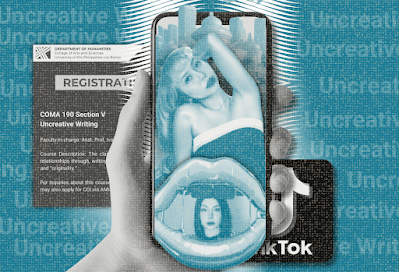“Uncreative Writing” as a Bold Expression (And do 'Toni Fowler Remix' and 'Brain Rot Videos' Redefine the Norm?)
Prince Carlo Estrella
This second semester of the academic year 2024–2025, UPLB offered a new topic for their Special Problem course (not a degree program; it is a “subject”), under the Department of Humanities in the College of Arts and Sciences. This new topic made rounds of discourse and was also shared everywhere by my colleague’s Facebook posts because it is everything that we are always told: “not to do”. And that is “Uncreative Writing”.
What is Uncreative Writing?
Now, what is “Uncreative Writing”? Based on the Facebook post made by the mentioned department: “The class embraces other ways of, materials for, and relationships through, writing while exploring values beyond "authorial voice" and "originality.”
In short, this is everything that Creative Writing is not because this course emphasizes the student’s mission of finding and embracing the other ways or mediums, materials, and relationships in “writing” that are not solely based on being published or put down on traditional mediums of “book” or “paper”.
Now, for some, that is not a “very UP student”-like, why should we allow this course to be offered? Why should we promote uncreativeness to our students? Shouldn’t we aspire to be, actually, more “creative”?
Well, before answering all that, let us define “uncreativity” by its dictionary definition, as shown by Google. Uncreativity, as an adjective or a quality, means not having or embodying any imagination or original ideas. This is exactly our world right now. In our postmodern world, especially in media, everything is just a copy or a reproduction of something else.
Brain Rot Culture as Uncreative Writing
Just look at the “brain rot” TikTok videos or memes that Gen Z people laugh at nowadays. This is uncreative writing (in my honest opinion) because these videos made by TikTok users all convey a story and messages by reusing and reappropriating existing funny videos, trends, and personalities—no matter how unhinged it might be for some.
 |
| Image screengrab of the writer from a TikTok video. |
The contents that this trend mostly references are either funny or eccentric personalities across different social media platforms like influencers. Outside of this realm, pets (like cats), iconic celebrities, memorable pop culture moments, and other cultural figures and phenomena are also being included in amusing TikTok content that can be categorized into either “core”/ “lore” videos, song remixes (like Toni Fowler ones, and Cuppcakke’s—which is the pioneer for this one), Floptropica world/Floptok contents, and the likes.
These contents have become so prevalent in our culture that it has now entered the realms of other social media platforms such as Facebook and Instagram. It is now everywhere to the point that it has finally surpassed its original purpose which is to entertain or make a Gen Z person laugh. It is now viewed as a public pedagogy because various content pages are now using these contents to educate viewers to learn about sciences, the classics (such as literature writers or movies), point out and critique societal issues or political news, and many more.
 |
| Image screengrab of the writer from a TikTok video. |
With that being said, it is obvious that this culture of “brain rot” contents, is something that can be truly considered as “uncreative writing” because it simply is. As even written and mentioned by the main proponent of this style, Goldsmith’s abstract for the book “Uncreative Writing” (2011): “...writers have the opportunity to move beyond the creation of new texts… and reconstruct those that already exist… including the use of Google searches to create poetry, the appropriation of courtroom testimony, and the possibility of robo[t]-poetics [and more]”.
 |
| Photo Courtesy of Chrissi Nerantzi. |
As a Culture and Pedagogy
Ultimately, this uncreative writing style of brain rot contents is not simply just “brain rot” anymore. It has now turned into a culture that dismantles the fact that learning can only be “done inside the classrooms”. Learning can now be through everything and everywhere in our world—even in your simple (skibidi) toilet break.
That is why, to answer the question about why we should even allow (or even promote) this kind of style to our students is simply because most literacy mediums have increasingly turned into a social capital and symbol that is mostly (and almost “only”) enjoyed by those who can afford it nowadays. The masses do not read books outside of school these days. Books are mostly enjoyed by the upper classes now.
To shed more light on this fact: no one wants to read books or literature nowadays largely because of its price. Books are more expensive than ever to the point that a monthly WiFi or Mobile Data connection is even cheaper these days. But this issue can all be solved through the means of “Uncreative Writing” because through such: we can finally reach the masses by communicating our ideas through everyday objects, materials, and other kinds of resources (might it be tangible or not). Thus eliminating hindrances to learning opportunities and makes knowledge now more fun and accessible to everyone, everywhere.
Everything is possible with “Uncreative Writing” because it opens up new learning opportunities by allowing the masses to experience and enjoy literature in ways similar to those offered by privatized books and other literacy resources. By embracing this form of writing, we can all unite to challenge further and gradually dismantle the capitalistic system that limits our access to knowledge and fosters division among us. Together, we engage in "Uncreative Writing" to write, share, and learn from our collective stories and experiences—as one community.

